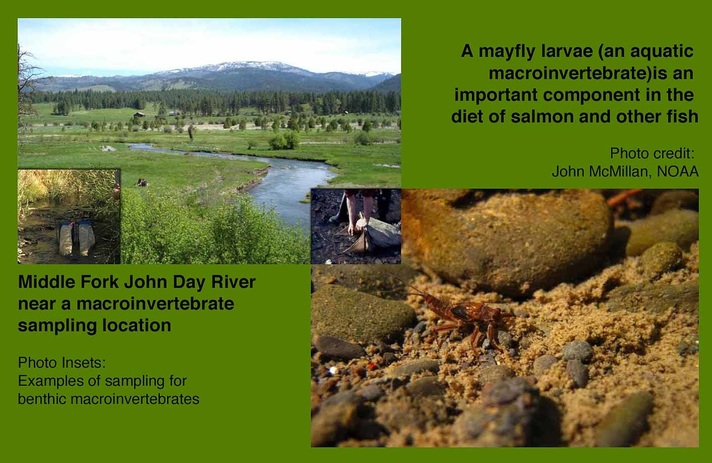 Since 2010 samples of insects living in the water (aquatic macroinvertebrates) have been collected at 15 locations in the Middle Fork John Day IMW by the North Fork John Day Watershed Council. Sample locations include sites that have had active restoration and locations that have not had any restoration activity. After collection, samples are sent to a lab where macroinvertebrates are identified and classified. Certain macroinvertebrates are only found in extremely healthy streams, while others are signs of poor water quality or disturbance. This data can be used to assess the ”biotic integrity,” or health, of the stream ecosystem. In 2014, Washington State University Tri-Cities graduate student Robin Henderson began analyzing three years of macroinvertebrate data from the Middle Fork John Day River IMW and the South Fork John Day River. Robin tested different models of biotic integrity for accuracy in prediction and then used those results to assess if restoration has improved the health in the Middle Fork John Day River. Robin’s initial analysis produced a highly accurate predictive model of biotic integrity. Her modeling results indicate macroinvertebrates respond to variables related to forest health and integrity, land use, habitat fragmentation and the riparian buffer zone, confirming that restoration activities implemented in the Middle Fork John Day river affect the biotic integrity of the watershed, at least in the short term. Supplementary data collection and additional analysis is needed to understand the longer term biological response. Macroinvertebrate collection will continue for several years and Robin’s model will be used again to determine if restoration activities have increased biotic integrity. Further research has also been proposed to characterize between-year variability of biotic integrity and to determine the regional climate drivers which may impact the biotic integrity of regional streams. For more detailed information on Robin’s research refer to the following resources… Henderson, Robin M. Measuring the Biotic Integrity of Stream Ecosystems with Restoration. MS Thesis. Washington State University, Richland. 2014. Henderson, Robin M. and James R. Pratt. Measuring the Biotic Integrity of Stream Ecosystems with Restoration. Washington State University Academic Showcase. 2014.
0 Comments
|
IMW News Updates
Archives
September 2022
Categories |
 RSS Feed
RSS Feed
